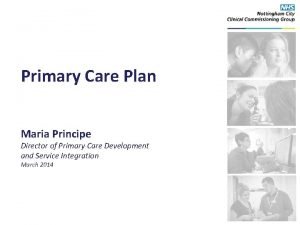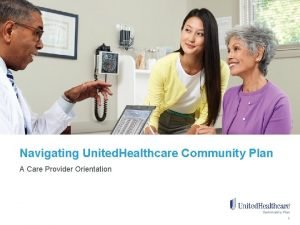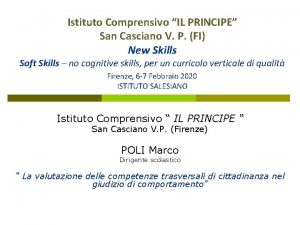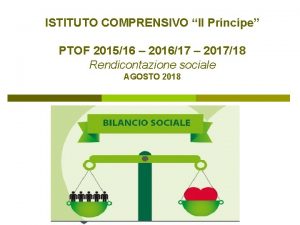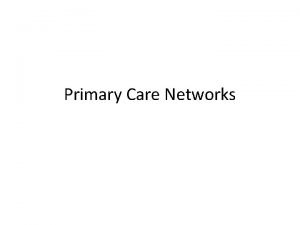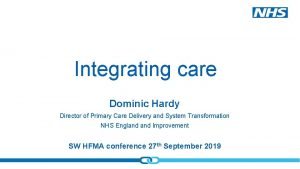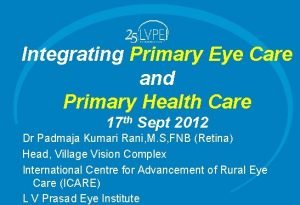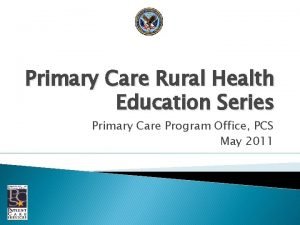Primary Care Plan Maria Principe Director of Primary



































- Slides: 35

Primary Care Plan Maria Principe Director of Primary Care Development and Service Integration March 2014

Our approach • National steer • Local challenges • Patient views National steer Primary Care Plan Patient views Local challenges

National steer • • • Access 8 am-8 pm, Weekend working Flexible access including email, Skype and phone consultations for those who might prefer it to face-to-face, when it is safe to do so Easier, on-line registration and choice of practice Joining-up of urgent care and out-of-hours care to ensure rapid walk-in access to care Greater flexibility about how people access general practice, for instance with the option to visit a number of GP surgery sites in their area Better access to ‘telecare’ to help people stay comfortable at home, as well as to healthy living apps Challenge fund A Call to Action GP contract • • • Improving outcomes • Strategic and operational plans • Allocation for CCGs • The tariff • Integrated Transfer Funds • Developing integrated plans • Working together • Competition • Local innovation • Intermediate actions Named GP for over 75 s Quality monitoring for out –of-hours (GPs who have opted out) Care plans Use of NHS number Online appointment booking Patients to order repeat prescriptions online Extended hours - extended with flexibilities to allow practices to work together to provide the most appropriate service for their patients Avoiding unplanned admissions enhanced service (case management, timely telephone access, shared information and data, GP 2 GP, discharge review, unplanned admissions review)

Local challenges • Transient and aging population • Variations in access to primary care medical services • Variations in clinical quality and patient health outcomes • Variations in service delivery (LESs, access etc) • Variations in the quality and size premises from which primary health care is delivered -------------- • Workforce concerns - shift in work but not in resources or funds • Financial management / competition / contract changes • Communication overload • Workforce retention, retiring GPs, shortage of primary care clinicians • Variations in service delivery/community services • Managing patient expectations National Steer Primary Care Plan Patient Views Local Challenges

Patient Views 600 surveys returned Access • Large support for GP telephone contact (312 - 65. 7%) • Happy for receptionist to signpost to nurse (under guidance) • Consistency of approach of access (324 - 74%) • Urgent appointments same day (259 - 59. 3%) • Routine appointment up to 3 days (147 - 33. 6%) • Routine appointment bookings 2 weeks in advance (110 - 25%) • Sit and wait drop-in clinics (rather than attending ED) • Saturday opening (339 - 77. 6%) • Sunday opening (110 - 25. 2%) General feedback • • • Flexibility of named GP, when urgent/same day Consistency required for LTC on-going treatment appointment required. (49%), (29. 7% yes if LTC related) Would like to see more use of technology All NHS resources should have Shared technology/data National Steer Primary Care Plan Patient Views Local Challenges

Relationships to Consider

Primary Care Vision Plan on a Page


How will the vision be achieved?

Integrate Care • Alignment of GPs within care delivery groups with LA including neighbourhood teams • Implementation of Care Co-ordinators to underpin and support CDGs. • Implementation of management MDT management of patient care • Promotions of shared working and workforce to alleviate current local and national pressures. GP Communities /Alliances

Innovative use of IT and Technology • Commissioning of Interoperability gateways to support and enable Information sharing between organisations • Promotion of NHS number between health and LA • Continued promotion of Innovative systems such as Electronic Prescriptions, Sunquest ICE, online patient records • Promote Mobile working • Remote visual Consultations • Assistive Technology / Innovative Technology • Online Booking • Skype • Telehealth • Telemedicine Neighbourhood Team

Standardize access and improve quality • Standardise approach / aspirations – Standardise access (1 day urgent, 3 day routine) – GP First/triage system – First line physio – Sit and wait ‘drop in’ – Promotion of self referral services – Utilisation of AQP for generals services to ensure equitable access and quality • Development of Pathways website • Development of 7 day working at CDG level** • Acute (Home) Visiting Service • Assistive Technology / Innovative Technology – Online Booking – Skype – Telehealth/Telemedicine Neighbourhood Team

Shared working/learning • Pilot of GP communities/Federations and alliances • Working with LMC to develop primary care infrastructure • • • Practice Visit programme Protected Learning Times Practice Manager development/forums Reception training Practice Nurse development/forums Responsiveness contract Neighbourhood Team

Promote shared responsibility • Communicate responsibility of managing resources in health, (cancelling appointments, using right services, using ED). • Commission self referral services, physiotherapy, podiatry, pain management, IAPT • Create self help advice and support within each practice • Promote the use of appropriate use of resources to adults and schools. (Social marketing).

How will this be funded?

Grey - Non recurrent CCG Yellow - Challenge Fund Quality & Responsiveness Contract Adoption or demonstration of innovative booking systems, access Frontline reception staff training Online Bookings /electronic prescribing Promote and adopt joint self referral corner Adopt and utilise Acute Home visiting service Working within agreed access standards, weekend opening Utilise Assistive Technology Care Delivery Groups, Shared Workforce, Federations, Joint Working Shared and accessible information and data Appropriate IT and infrastructure

What will success look like? Improved Primary Care access • Uptake, usability, satisfaction Improved patient outcomes • Focus on self-care, clinical communities, and equitable care Improved cost-effectiveness • Earlier presentation, unnecessary interventions avoided • Assist GP productivity, net savings on unnecessary interventions

GP Federations Jason Mather Primary Care Development and Service Integration Manager March 2014

Examples of GP communities Federations and alliances • • • Working closer together Support Better care Group of practices/primary care teams working together Sharing responsibility for delivering services

Clifton Group of practices

Bulwell Pilot

Bulwell Pilot

Area Six Health Care Alliance • Seven Practices patient population of approx. 40, 000 • Practice manager led • Economies of scale • Inter-practice Agreements • Subcontract • Share the risk of meeting KPIs • Cross refer patients within the alliance • Strength in depth • Closer relationships to provide better care for their patients Work Smart Rise to the challenges facing primary care

Community Services Development Hazel Wigginton Head of Primary Care Development and Service Integration March 2014

Commissioning Strategy Strategic Priorities Priority 3 Long term conditions Priority 4 Improving the Health and Wellbeing of the frail and elderly

Long Term Conditions (Priority Areas) • • Diabetes Respiratory conditions BME background Cardiology

Diabetes (service development) • Integrated Diabetes Service • T 2 ONIC (Structured Education) • Expansion of Diabetes Specialist Nursing Service • Rolling programme of diabetes care • On-going training and education • Care planning introduced

Respiratory Disease (service development) • • Integrated Respiratory Service Respiratory PLT sessions On-going training and education Generic care planning being explored

BME Progress • Research project agreed • Looking at ways of increasing uptake of services and patient engagement • Targeted screening

Cardiology (service development) • Primary Care Cardiac Service • Newly diagnosed stable angina patients (or those with a change in their condition) • IV diuretics • Discharge criteria introduced • NUH support formalised

Frail Elderly / Integrated Care (Priority Areas) • • • Risk profiling tool Partnership working with City Council Community nursing and rehabilitation Independence pathway Care homes Assistive technology

Frail Elderly / Integrated Care (service development) • • Care delivery groups configured Neighbourhood teams established Care coordinators appointed Social care links being identified Risk profiling tool established Falls (EMAS) rapid response service Community services development

Links to Integrated Care Phase 2 (1 April to 31 July) • • • Falls and bone health Speech and language therapy Local authority Ots Tissue viability Community neurology Community stroke End of life Primary care cardiac service Integrated respiratory service

Links to Integrated Care Phase 3 (1 August to 30 November) • • • Continence Mental Health Services for Older People Nutrition and dietetics Integrated diabetes service Community diabetes specialist nursing service

Any Questions?
 Health care levels primary secondary tertiary
Health care levels primary secondary tertiary Mather primary care
Mather primary care United healthcare community plan primary care providers
United healthcare community plan primary care providers Maria felicia de jesús sacramentado maría teresa arminda
Maria felicia de jesús sacramentado maría teresa arminda Schéma de principe d'une paire de ciseaux
Schéma de principe d'une paire de ciseaux Symboles normalisés
Symboles normalisés Mécanique du solide
Mécanique du solide Onderdelen spectrofotometer
Onderdelen spectrofotometer Le dosage en retour
Le dosage en retour Protines
Protines Déontologie
Déontologie Pfs statique
Pfs statique Ferraillage poutre continue
Ferraillage poutre continue Principe d'incertitude d'heisenberg
Principe d'incertitude d'heisenberg Principe de heisenberg
Principe de heisenberg Linking pin voorbeeld
Linking pin voorbeeld Constante d'equilibre
Constante d'equilibre Principes moraux exemples
Principes moraux exemples Principe de bernoulli
Principe de bernoulli Principe de le chatelier
Principe de le chatelier Technique du monotype
Technique du monotype Enthalphie
Enthalphie Arbre haccp
Arbre haccp Istituto comprensivo il principe san casciano
Istituto comprensivo il principe san casciano Comprensivo il principe
Comprensivo il principe Parachute ascenseur fonctionnement
Parachute ascenseur fonctionnement Dynamique de rotation
Dynamique de rotation Loi de bragg
Loi de bragg Premier principe de la thermodynamique
Premier principe de la thermodynamique Premier principe de la thermodynamique
Premier principe de la thermodynamique équation de van deemter
équation de van deemter Gauss el principe de las matematicas
Gauss el principe de las matematicas Principe atg
Principe atg Bert van hemert
Bert van hemert Principe de dénombrement
Principe de dénombrement U en thermodynamique
U en thermodynamique

